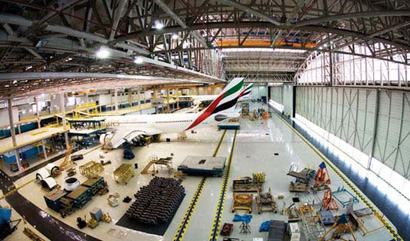"7:00am: Emirates staff arrive at the new Group Headquarters building by bus, car-pool and on the new Dubai Metro rail system – significantly reducing their ground transport emissions. Car-poolers are offered priority parking in the staff carpark, while Metro commuters access the building directly from EGHQ’s own dedicated Metro station.
 8.00am: Emirates executives are meeting with one of our aircraft suppliers about how to save more weight from aircraft design. Collaborative design and planning will help save weight, fuel burn and CO2 emissions. Pursuing lighter and stronger materials in aircraft chosen by Emirates makes them more efficient, burning less fuel and therefore reducing emissions. One example involves Emirates and Airbus cutting five tonnes of structural weight from future A380s. 8.30am: In Seattle, Emirates takes receipt of one of its new Boeing 777 aircraft. With 86 in service and 50 on order, Emirates is the largest operator of the 777 and the only airline to fly every model in the family (including 200, 300, extended range, ultra long range and freighter variants). This particular aircraft will help maintain Emirates’ average fleet age at around five years, less than half the global average of 11 years. Investing in and operating a modern, fuel efficient fleet is the single biggest environmental contribution Emirates, or any airline, can make. 8.45am: A customer in Mumbai checks in to fly to Dubai using our electronic check-in system. To date we have saved significant quantities of paper using this process and therefore thousands of mature trees. Emirates enforcement of set cabin and hold baggage weight limits ensures that for every kilogram of weight saved, 34,000 litres of fuel is saved each year. 10.10am: An Emirates flight has departed for Melbourne. Using pioneering technology developed by Emirates and Airservices Australia (ASA), this aircraft will follow high-altitude winds to save precious time and resources on this 14 hour journey – making up to an 8% fuel saving. Instead of using traditional fixed route structures over land-based navigation fixes, we have worked with ASA to develop and utilise inertial GPS-enhanced navigation fixes that will allow the flight to follow the best tailwind to track deep into the Southern Indian Ocean on its way Down Under. 11.00am: Emirates new A380 aircraft is departing for Toronto. This aircraft, which is 30% quieter as it departs Dubai and lands into Lester B Pearson International, will also use up to 20% less fuel per passenger than typical other aircraft crossing the Atlantic. 2.00pm: Emirates cabin crew arrive at Group Headquarters in Dubai by bus from staff accommodation. They are seamlessly checked in and move from Headquarters to the airport and aircraft through an advanced design that was purpose-built for Emirates to ensure efficiency, ease of travel and best use of resources. They access their departing aircraft by a specially designed tunnel connecting Headquarters to the airside terminal and aircraft. Much of Emirates new dedicated airport infrastructure at Terminal 3 is underground which can reduce energy consumption by as much as 80%. 2.20pm: Employees from dnata and other Emirates Group companies are meeting to plan their annual UAE Environment Day, tree planting programme and to finalise preparations for their clean waterways initiative, where 30 employees will don scuba gear to help keep Dubai’s famous waterway cleaner for another year. 4.00pm: One of Emirates new Boeing 777-300ER aircraft, which is powered by two of the largest and most fuel efficient commercial aircraft engines in the world, is taxiing to its aerobridge at Dubai Airport after landing from London. The flight crew are using just one engine to taxi the aircraft, saving precious fuel, and reducing greenhouse gas emissions. 4.30pm: Emirates Engineering staff are weighing various materials that have been stripped and separated from the interiors of one of thirty three Boeing 777 aircraft, as part of an ongoing refurbishment project. This means that some 12 tonnes a month of aviation grade aluminium, scrap metal, polycarbonate plastic, carpet and seat cloth is diverted from landfill, while also generating significant revenues. 5.15pm: In Emirates state-of-the-art Flight Catering facility in Dubai, employees are separating waste for recycling, while producing over 96,000 meals per day for 130 airlines,. This year, Emirates Flight Catering will recycle over 1.5 million kilograms of paper, cardboard, plastic bottles, aluminium cans, foils, plastic bags, waste oil and wooden pallets from our flight catering operations (including 15 tonnes per month from on-board waste). 6.35pm: An Emirates aircraft is flying over Ukrainian air space on its way to New York. This was previously a rarity until Emirates negotiated aviation access in Ukrainian airspace on certain routes that saves five minutes per flight, resulting in less fuel consumption and less emissions. 9.30pm: An Emirates flight from Germany lands at Dubai Airport. All newspapers and paper waste on board is separated by our ground crew and prepared for recycling. Five tonnes a day of paper will be recycled, saving 35,000 trees a year. 11.05pm: Members of Emirates Engineering are cleaning the engines of an Emirates SkyCargo aircraft as part of its regular maintenance process. A clean and well maintained engine is at its most efficient and will use less fuel. Carbon dioxide emissions are also cut. The team are ensuring they remove pollutants that stick to the compressors of engines to allow for future optimal performance. All oily water is recovered during the process and is treated in a specialised liquid waste treatment plant off-site."
As quoted in Emirates.com
MOST POPULAR IN LAST 24 HRS
MOST POPULAR IN LAST 7 DAYS
|